Building a website can feel like sorting through a box of puzzle pieces when all you want is a clear picture for your business. Some options offer instant results with just a few clicks while others promise the power to create something unique that matches your brand. Fast setup, flexibility, design control and support all come into play and each choice has its own approach. Wondering which one meets your needs and makes life easier? The answer depends on what matters most to you. Keep reading to see how the most popular website builders stack up and what makes each one stand out.
Table of Contents
Responsive Website Design NZ
At a Glance
Responsive Website Design NZ is a specialist digital agency focused on WordPress websites for small to medium-sized businesses. They combine rapid deployment with long-term support, delivering visually engaging, mobile-responsive sites that are engineered for SEO and user engagement. If you need an e-commerce-ready site or ongoing maintenance and security, they provide a single partner to handle it from design through to optimisation and updates. Bottom line: a reliable, expert choice for businesses that want a professional WordPress presence without the guesswork.
Clear. Practical. Effective.
Core Features
Responsive Website Design NZ offers end-to-end WordPress services built around practical business outcomes. Key capabilities include responsive website design and development, custom WordPress development, SEO optimisation, and guaranteed mobile responsiveness. They handle e-commerce website development using WooCommerce and bespoke solutions, plus website redesign services. Ongoing website maintenance, security updates, and performance and security audits with continuous optimisation round out the offering — so sites don’t just launch, they keep performing and ranking.
Pros
- Specialised WordPress expertise: Their focus on WordPress enables tailored solutions that fit specific business workflows and future-proof your site.
- SEO and engagement-first approach: Projects are built to attract traffic and convert visitors, not just to look good.
- Comprehensive lifecycle support: From initial design and launch to ongoing management and security, they offer a single accountable partner.
- Fast deployment capability: The team emphasises quick turnaround without sacrificing quality, helping businesses go live sooner.
- E-commerce and custom development support: Built-in WooCommerce experience and bespoke coding options mean complex store requirements are achievable.
Who It’s For
This service suits small to medium enterprises, local retailers, and organisations that need a professional, SEO-optimised WordPress website plus ongoing care. You’re a good fit if you want a site that is mobile-first, simple to manage, and designed to increase online visibility or sales. If you prefer a hands-off provider for maintenance, security and performance tuning, this team is matched to your needs.
Unique Value Proposition
Responsive Website Design NZ stands out by combining deep WordPress know-how with a full-service support model tailored for businesses that need measurable results. Rather than selling templates or one-off builds, they craft customised WordPress solutions focused on SEO, conversion and long-term stability. Their integration of WooCommerce with custom development ensures e-commerce projects are built to the client’s processes — not the other way around. Ongoing maintenance, security updates and regular performance audits mean the website remains an asset, not a liability. In short: they turn WordPress into a strategic platform for growth, offering continuity and technical stewardship that typical freelance or DIY approaches rarely deliver.
Real World Use Case
A local New Zealand retailer commissions a new site: a mobile-first, SEO-optimised WooCommerce store that’s easy to manage and scales with inventory. Responsive Website Design NZ builds the store, configures secure payment workflows, implements SEO best practice and provides ongoing updates and performance tuning so the retailer can focus on sales — not site upkeep.
Pricing
Quote-based: get a free quote by filling out the form on their website.
Website: https://responsivewebsitedesign.co.nz
Squarespace
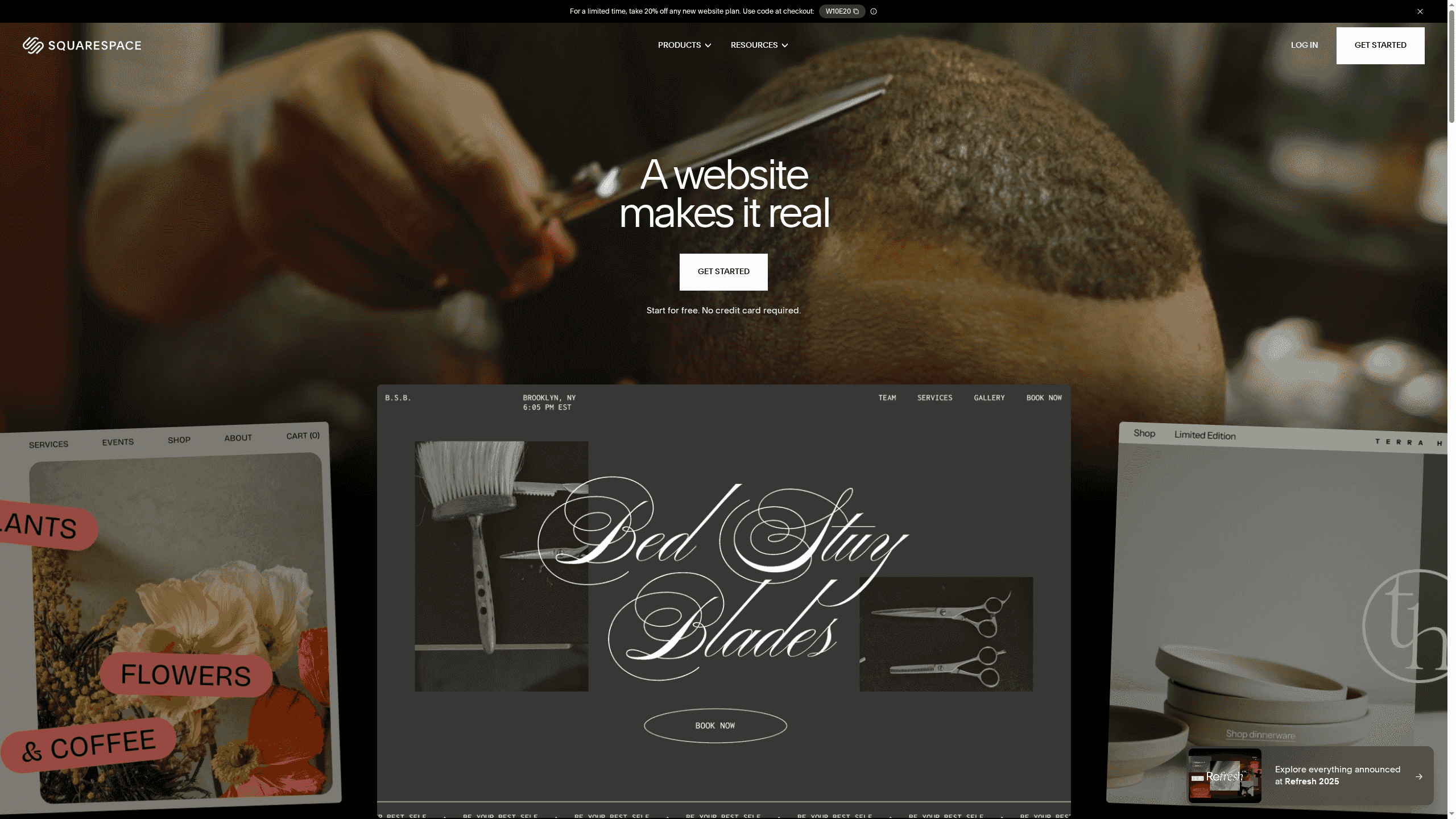
At a Glance
Squarespace is an all-in-one website builder that simplifies site creation with professionally designed templates, an intuitive drag-and-drop editor, and AI-assisted content tools. It supports stores, portfolios, blogs and service sites, and bundles SEO, marketing and domain management into one platform. If you want a fast, polished online presence without coding, Squarespace delivers — with trade-offs for deep customisation and cost-sensitive projects. Bottom line: great for entrepreneurs and small businesses who prioritise speed, design and convenience.
Core Features
Squarespace combines a drag-and-drop website editor with AI website-building and content-generation tools, a wide selection of professional templates, and built-in e-commerce capabilities for online store management. It also includes domain registration and privacy/security features, integrated analytics to track performance, multiple payment and shipping options, and social media plus third-party extensions for broader functionality. These features work together to cover the full lifecycle of a site: build, promote, sell and measure.
Pros
- User-friendly drag-and-drop website builder: The editor lets you create pages and adjust layouts without writing code, so you can launch quickly.
- No coding knowledge required: Non-technical users can manage content, products and settings without developer support.
- Wide selection of professional templates: Built-in templates provide polished starting points for portfolios, stores and service sites.
- Robust e-commerce features: Online store management, multiple payment options and shipping tools let you sell products and handle orders within the same platform.
- Strong SEO and marketing tools: Integrated SEO settings and marketing features make it easier to optimise pages and run campaigns from one dashboard.
- Built-in domain and security features: Domain registration and privacy/security controls are included, simplifying setup and site ownership management.
Cons
- Pricing may be higher compared to some competitors: The convenience and integrated tools come at a cost that may not suit small budgets.
- Limited customisation options for advanced users: Developers seeking deep code-level control may find the platform restrictive.
- Some features require paid plans: Advanced e-commerce and marketing capabilities are locked behind higher-tier subscriptions.
- Dependence on platform templates may limit unique branding: Relying on supplied templates can make it harder to achieve a completely bespoke look.
Who It’s For
Squarespace is ideal for entrepreneurs, small business owners, freelancers and creators who need an attractive, functional website without hiring developers. If your priority is a fast, reliable launch with integrated sales and marketing tools rather than extensive custom code, Squarespace fits well.
Unique Value Proposition
Squarespace’s strength is its unified approach: design-led templates, AI-assisted content creation and a single dashboard for domains, commerce and analytics. That reduces tool sprawl and lets small teams manage their online presence from one place.
Real World Use Case
A small retail business uses Squarespace to showcase products, accept online payments and run marketing campaigns — all managed inside the same platform, which streamlines operations and keeps costs predictable.
Pricing
Starting at $16/month after a 14-day free trial, with various plans offering enhanced features like e-commerce and marketing tools.
Website: https://squarespace.com
Wix.com
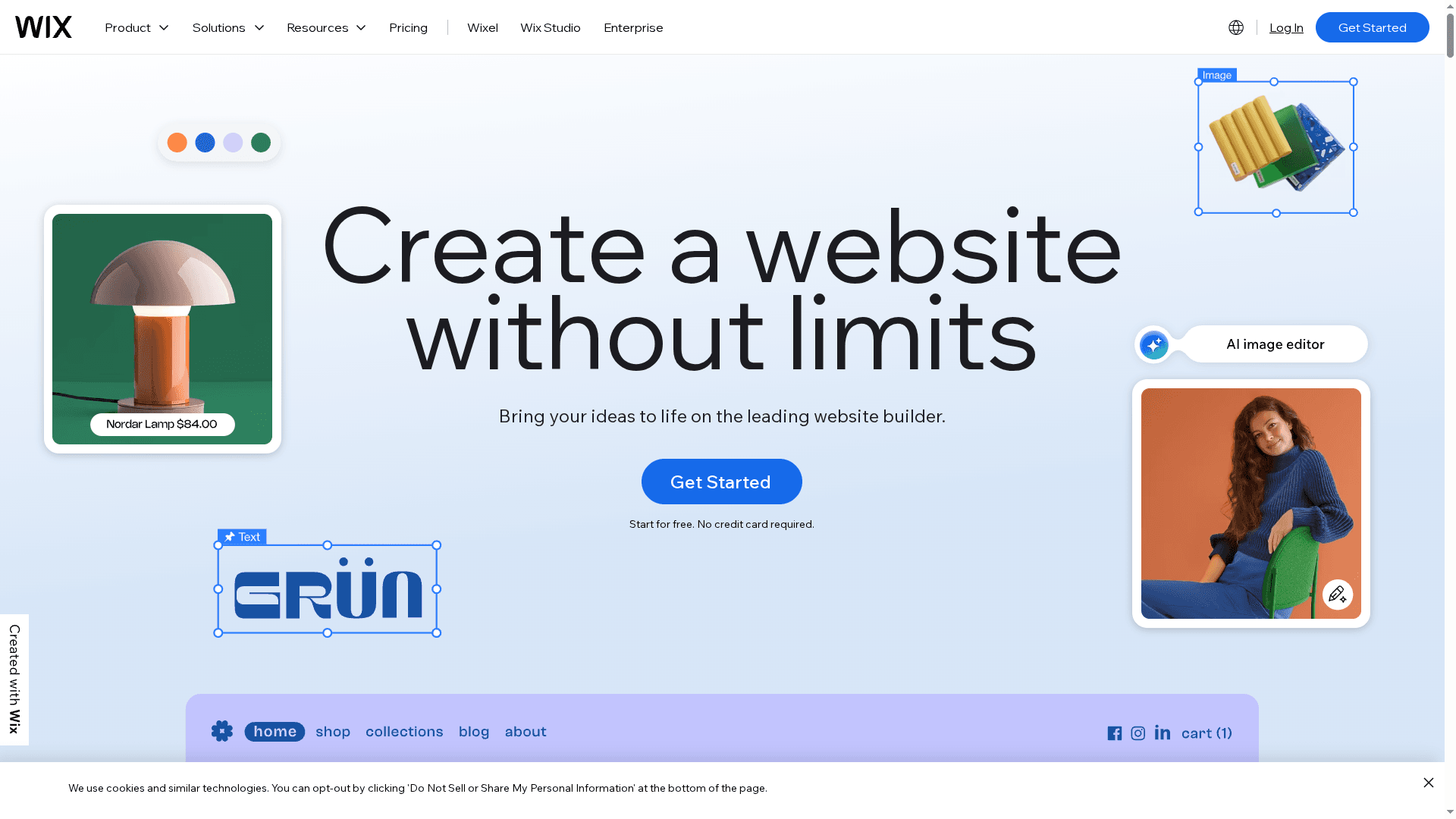
At a Glance
Wix is an all-in-one website builder that lets you create a professional site without writing code, using a drag-and-drop editor and AI-assisted tools. It’s strong on ease of use, with hundreds of templates and built-in hosting, domain services and marketing features that suit small businesses and individuals. However, its convenience comes with some trade-offs in flexibility and cost for advanced features. Bottom line: a fast, user-friendly route to a polished website, especially when you need speed and simplicity over deep customisation.
Core Features
Wix combines an AI website builder for rapid starts with a drag-and-drop editor and more than 900 customizable templates spanning multiple industries. The platform bundles domain registration, multi-cloud hosting, security and uptime assurances alongside integrated marketing and SEO tools, social media and email marketing, analytics, and ecommerce functions such as product management and payments. Mobile-optimised pages and reporting round out a toolkit designed to take a site from idea to live without stitching together multiple vendors.
Pros
- User-friendly interface suitable for beginners: The drag-and-drop editor and AI tools make it straightforward for non-technical users to build a site quickly without developer input.
- Extensive template and design customisation options: With 900+ templates you can find an industry-appropriate starting point and then tailor visuals and layout to reflect your brand.
- All-in-one platform including hosting, domains, and marketing: Wix removes the need to manage separate hosting or third-party marketing integrations, simplifying ongoing site management.
- No coding required, ideal for non-technical users: The platform’s core selling point is that business owners can maintain and update their sites themselves.
- Strong security and high uptime reliability: Built-in hosting and security features mean fewer infrastructure concerns for small businesses focused on operations.
Cons
- Limited flexibility compared to custom-developed websites: For bespoke functionality or highly complex integrations, Wix cannot match the adaptability of a custom WordPress build.
- Some advanced features available only on higher plans: Access to certain ecommerce, marketing or business tools requires upgrading to premium tiers, which can be restrictive for tight budgets.
- Costs can escalate with premium plans and add-ons: While a basic free tier exists, real business use often pushes sites toward paid plans and paid add-ons, increasing total cost.
Who It’s For
Wix suits individuals, small businesses and organisations that prioritise speed to market and ease of use over deep technical customisation. It’s ideal if you want to manage your own site, launch an online store quickly, or run marketing campaigns without assembling multiple vendors. If you plan to scale into highly customised workflows, factor that into your decision.
Unique Value Proposition
Wix’s core value is convenience: it packages design, hosting, domains, ecommerce and marketing into a single interface powered by AI and a vast template library. That removes friction for business owners who prefer a single platform they can operate themselves rather than contracting ongoing developer support.
Real World Use Case
A small boutique can use Wix to launch an online store with integrated payment processing, marketing tools and a custom domain, allowing it to reach customers nationally while managing inventory and promotions from the same dashboard.
Pricing
Starting free with basic features; premium plans range from $17 to $159 per month depending on features and business needs.
Website: https://wix.com
Webflow
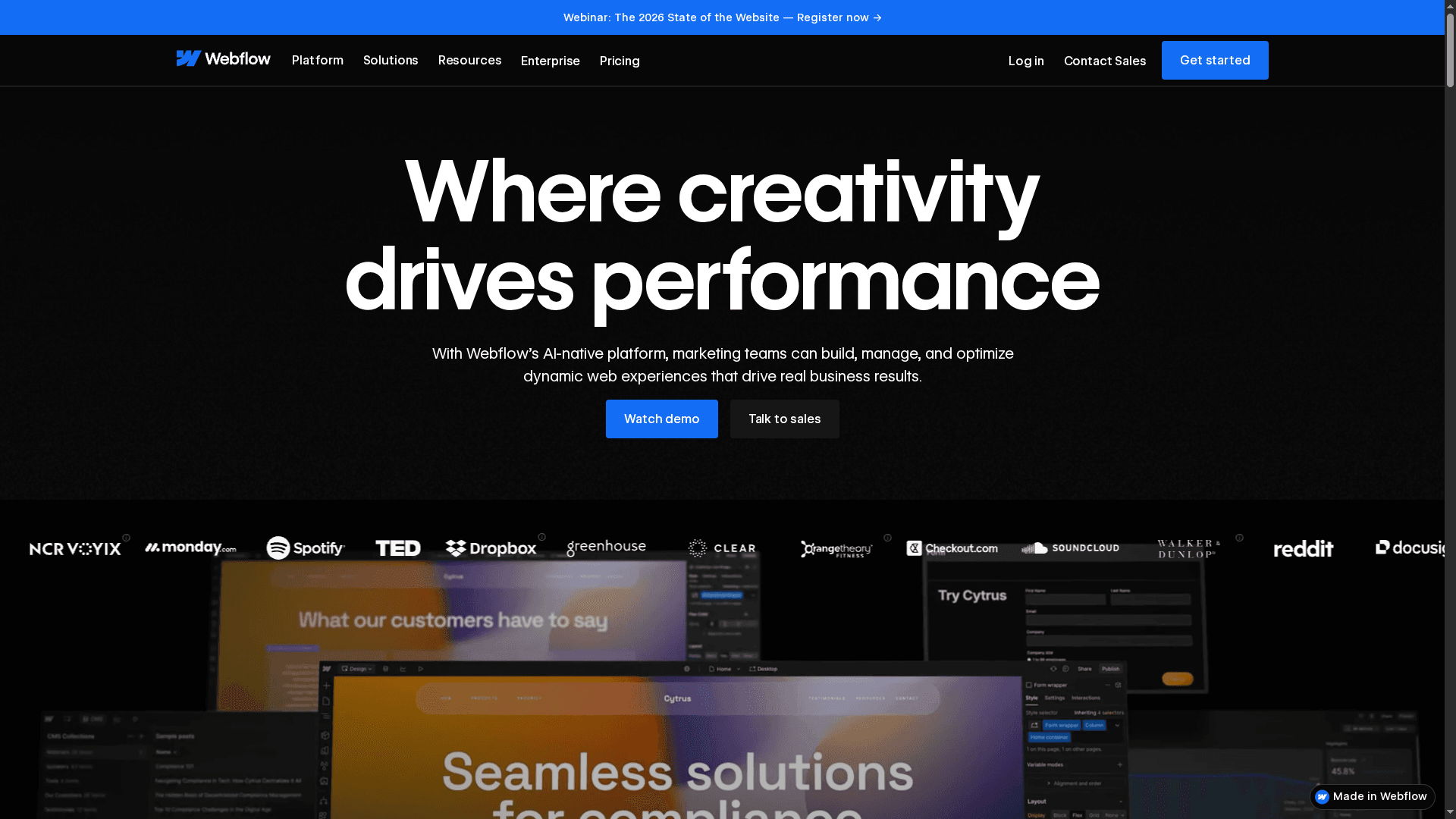
At a Glance
Webflow is a visual website builder that combines drag-and-drop design, a built-in CMS, hosting and AI-driven optimisation to help teams move from idea to impact faster. It’s strong for marketers, designers and agencies who want a single platform for design, content management and performance tracking. But it isn’t a silver bullet — pricing and certain technical limits can catch smaller teams off guard.
Core Features
Webflow’s core strength is a visual website builder that exposes granular design controls without forcing you to write HTML and CSS for every change. Paired with a Content Management System, it lets teams manage content at scale while keeping design fidelity. Built-in SEO tools and AI-driven optimisation help tune pages for search and conversions, while first-party hosting provides scalability and security. Enterprise plans add integrations such as Figma, React and third-party APIs, plus AI-powered personalisation and localisation, analytics and real-time collaboration with commenting for team workflows.
Pros
- Visual, non-coding design: The drag-and-drop interface lets non-coders create polished layouts while maintaining precise control over responsive behaviour.
- Integrated CMS and hosting: Having content management and hosting in one platform reduces handovers and simplifies ongoing maintenance and backups.
- SEO and performance tools: Built-in SEO features and AI-driven optimisation make it easier to tune pages for search and loading speed without external plugins.
- Collaboration-ready: Real-time collaboration and commenting support team-based workflows and cut review cycles.
- Advanced extensibility: White-label options and custom code support give agencies and developers room to extend functionality where needed.
Cons
- Pricing pressure for small teams: Pricing can be high for small teams or solo users who need advanced features and hosting at scale.
- Less flexibility than hand-coding: Design flexibility is excellent for visual workflows but remains limited compared with fully hand-coded sites for bespoke interactions or rare edge cases.
- One-way exported code: If you export site code from Webflow, it cannot be re-imported for editing within the platform, which complicates migration strategies.
Who It’s For
Webflow suits marketing teams, designers, developers and agencies that want an all-in-one platform to design, build and host production websites with minimal manual setup. If you need rapid prototyping, strong CMS support and built-in SEO without wiring together multiple services, Webflow is a pragmatic choice.
Unique Value Proposition
Webflow’s unique value is its blend of pixel-level visual design and a production-ready CMS plus hosting, all coupled with AI-native tools for optimisation and personalisation. That combo shortens time-to-live and keeps creative control within the team rather than handing everything to developers.
Real World Use Case
A digital marketing agency used Webflow to prototype and launch a client website, cutting development time by 50% while leveraging integrated SEO and analytics to lift traffic and conversions — a clear demonstration of faster delivery plus measurable business outcomes.
Pricing
Starting at $0 (free plan available); paid plans from $14/month for basic sites up to custom enterprise solutions.
Website: https://webflow.com
WordPress.com
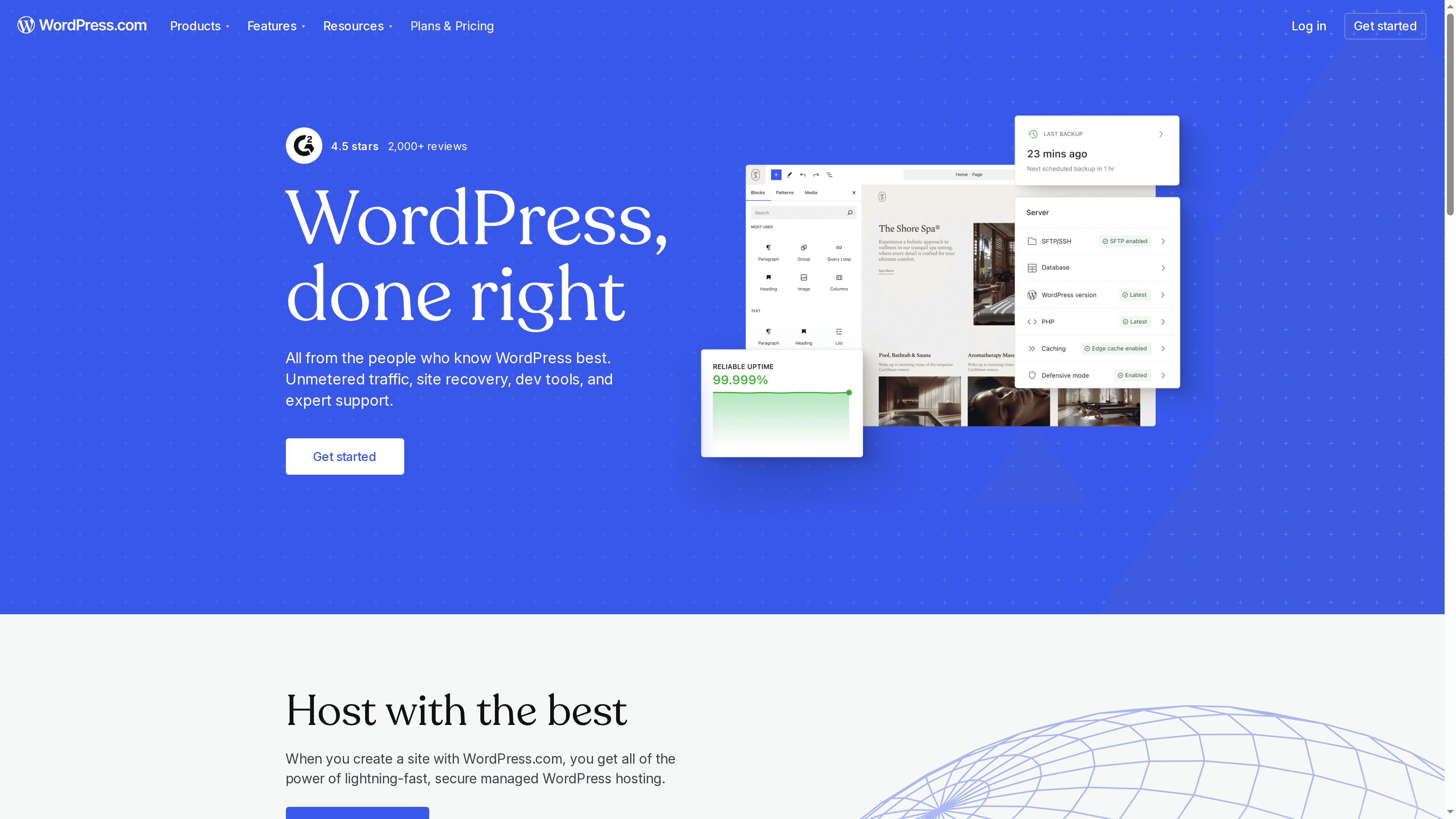
At a Glance
WordPress.com is a full-service platform that combines site building, managed hosting, domain management and e-commerce tools into a single package. It suits everyone from individuals launching a blog to organisations needing scalable, enterprise-grade publishing. The platform’s managed approach delivers built-in security and performance, but some advanced capabilities sit behind higher-tier plans and enterprise pricing can be costly.
Core Features
WordPress.com provides a website builder with themes and pattern-based design, plus managed WordPress hosting that includes security and performance features out of the box. It bundles domain registration and management (often with a free first-year domain), a choice of personal, premium, business and enterprise plans, and e-commerce support through WooCommerce integration — giving you the tools to run online stores alongside regular content sites.
Pros
- All-in-one offering: It combines website creation, hosting and domain services so you can manage everything from a single dashboard without stitching multiple vendors together.
- Wide customisable themes and plugin options: You get a broad selection of design patterns and the ability to extend functionality through plugins, which speeds up development and saves time on custom builds.
- Built-in security and performance: Managed hosting includes security measures and optimisation features, reducing the time and technical effort required to keep sites safe and fast.
- Flexible plan tiers: Plans scale from beginner-friendly options to enterprise solutions, allowing businesses to upgrade as they grow without migrating platforms.
- Multilingual and monetisation support: The platform supports multilingual sites and a range of payment and monetisation options, enabling international reach and revenue generation.
Cons
- High enterprise pricing: Enterprise-level plans can be expensive, with quoted starts around $25,000 per year, which may be prohibitive for many small organisations.
- Limited custom server configuration flexibility: Because hosting is managed, there are constraints on custom server-level configurations that technically advanced teams sometimes need.
- Advanced features behind higher tiers: Capabilities such as expanded analytics and deeper third-party integrations often require upgrading to mid or top-tier plans, increasing the total cost.
Who It’s For
WordPress.com is ideal for individuals, small to medium businesses and enterprises that want a secure, scalable and easy-to-manage website platform. If you prefer managed hosting, value integrated domain and e-commerce tools, and want to avoid the operational overhead of self-hosting, this platform is a strong fit.
Unique Value Proposition
The unique value lies in delivering managed WordPress hosting and site-building tools together — so you get professional performance, security and a large ecosystem of themes and plugins without needing to administer servers or piece together services.
Real World Use Case
A small local business can use WordPress.com to launch a professional website with an integrated online store, leveraging customisable themes, built-in security and WooCommerce integration to sell products and manage sales without hiring a developer for infrastructure work.
Pricing
From free (basic features) to enterprise plans starting at $25,000/year.
Website: https://wordpress.com
Weebly
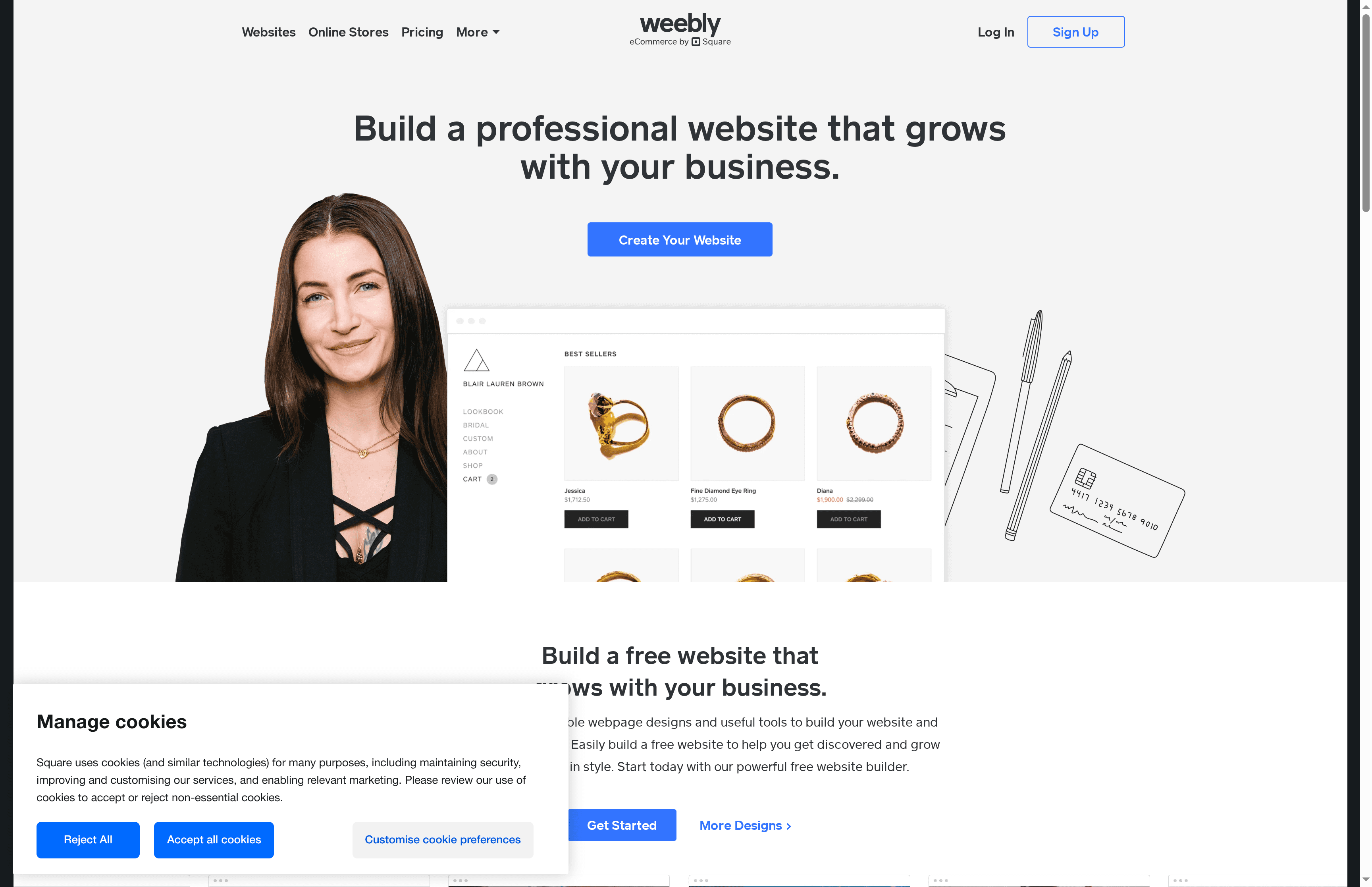
At a Glance
Weebly is a straightforward website builder that combines free and paid plans with built-in ecommerce and marketing tools to help small businesses get online quickly. It’s especially useful for owners who want guided setup, integrated payments via Square, and practical support resources without a steep learning curve. It won’t replace a fully custom WordPress build for complex projects, but it delivers a fast, all-in-one option for launching and growing an online presence.
Core Features
Weebly’s core capabilities centre on easy website and online store creation, with customizable webpage designs and ecommerce tools such as order management, shipping and payments. The platform includes integrated marketing features — think Facebook ads and email campaigns — and direct Square payment integration for seamless selling across online stores and pop-up shops. Support comes through tutorials, a blog, community events and direct customer service by email, chat and phone, plus additional services like professional product photography and branding tips.
Quick note. Simple wins often beat complexity.
Pros
- Free basic plan available: You can start building a site and test the platform without financial commitment.
- Integration with Square payments enhances selling capabilities: Direct Square links simplify in-person and online transactions for retailers.
- Allows connecting custom domains with paid plans: Upgrading lets you brand your site with a custom domain name.
- Comprehensive ecommerce features for growth: Order management, shipping and payment tools cover the essentials for scaling sales.
- Supportive resources and community events: Tutorials, blog content and events help you learn and improve your site over time.
Cons
- Paid plans are necessary for advanced features and custom domains: The free tier limits access to several important capabilities that businesses typically need.
- Features and tools can vary widely across different plans: What you expect on one tier may not be available on another, which can complicate budgeting.
- Some advanced ecommerce features may require additional costs: Growing stores may face extra charges for advanced functionality beyond the base plan.
Short and plain. Consider trade-offs carefully.
Who It’s For
Weebly suits small business owners, entrepreneurs, creatives and startups who need an easy-to-use, all-in-one website and online store builder with integrated marketing and payment features. If you value speed to market, guided tools and ongoing support over deep customisation, Weebly is a pragmatic choice.
Unique Value Proposition
Weebly’s unique value lies in bundling site design, ecommerce and marketing with Square payment integration and hands-on support, all in a single platform. That combination reduces the number of separate systems you must manage and gets you selling faster — useful when time and simplicity matter more than bespoke development.
Real World Use Case
A small boutique owner can use Weebly to build an attractive online store, manage inventory, process payments through Square at both market stalls and online, and run targeted marketing campaigns to increase customer engagement and sales.
Pricing
Starting at $10/month for paid plans; free plan available. Paid plans listed include Personal at $10/month, Professional at $12/month and Performance at $26/month (billed annually).
Website: https://weebly.com
Website Building Platforms Comparison
This table compares various website building platforms, highlighting their key features, pros, cons, pricing, and ideal users to help you find the best fit for your needs.
| Platform | Key Features | Pros | Cons | Pricing |
|---|---|---|---|---|
| Responsive Website Design NZ | WordPress expertise, e-commerce, SEO, custom development | Tailored WordPress solutions; fast deployment | Quote-based, might not suit all budgets | Quote-based; contact for details |
| Squarespace | All-in-one platform, drag-and-drop editor, SEO tools | User-friendly; no coding required; integrated commerce | Higher cost; limited customisation for advanced users | Starts at $16/month |
| Wix.com | Drag-and-drop editor, AI tools, extensive templates | Easy for beginners; extensive templates; all-in-one solution | Limited flexibility; costs can escalate | Free plan; premium starts at $17/month |
| Webflow | Visual design tools, CMS, AI optimisation | Non-coding design; strong CMS; collaboration-ready | High pricing; less flexible than hand-coding | Free plan; paid plans from $14/month |
| WordPress.com | Themes, plugins, managed hosting, WooCommerce | All-in-one; customisable themes; multilingual support | Expensive enterprise plans; server configuration limited | Free basic; enterprise from $25,000/year |
| Weebly | Guided setup, integration with Square, marketing tools | Free plan; Square integration; supportive resources | Paid plans needed for advanced features; features vary by plan | Free plan; paid plans from $10/month |
Elevate Your Web Design Strategy with Expert WordPress Solutions
Navigating the best web design tools can leave you overwhelmed with choices and uncertain about the results for your business. The article highlights the need for websites that are not just visually appealing but also responsive, SEO-friendly and aligned with your unique business goals. You want a solution that goes beyond templates and quick fixes to truly own your online presence with seamless user experience and measurable growth.
Discover how our team at Responsive Website Design NZ specialises in crafting customised WordPress websites tailored for New Zealand businesses just like yours. Whether you are starting fresh or aiming to redesign your current site, we deliver mobile-responsive, SEO-optimised solutions with ongoing maintenance and security. This ensures your website remains a powerful asset that adapts and grows with you.
Explore our approach to web design and development in the Website Archives to understand how we blend creativity with technical expertise for lasting impact.
Looking for inspiration or need to understand diverse challenges faced by businesses in the digital landscape? Visit our Uncategorized Archives for fresh insights.
Ready to transform your online presence with a reliable WordPress partner who understands your goals and market?
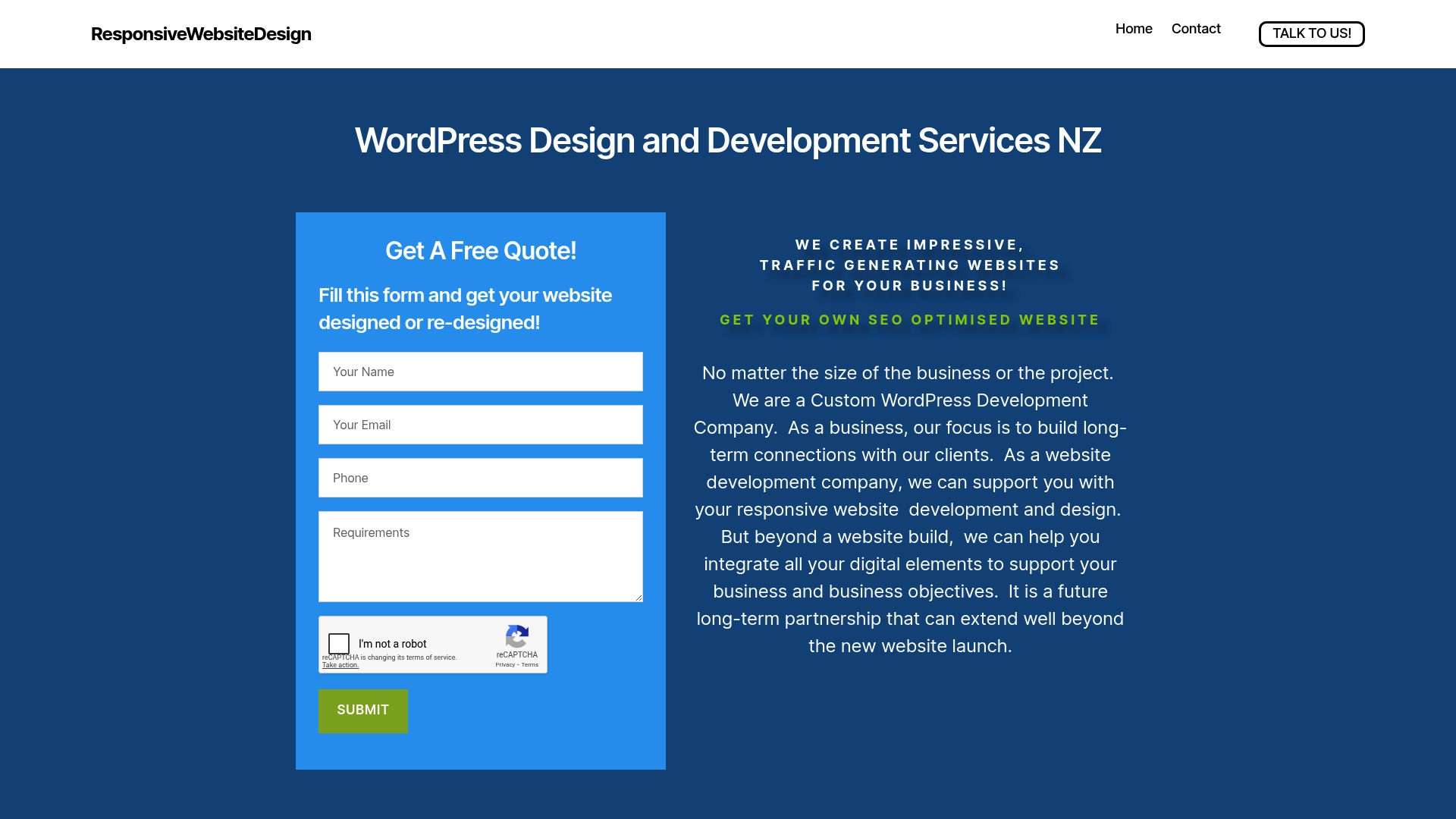
Take the first step today by contacting us at Responsive Website Design NZ to get a personalised quote and discover how our expert team can bring your digital vision to life quickly and effectively.
Frequently Asked Questions
What are the key features to look for in the best web design tools in 2025?
The best web design tools should offer responsive design capabilities, customizable templates, intuitive drag-and-drop interfaces, and built-in SEO features. Evaluate tools based on these criteria to ensure they meet your project requirements effectively.
How can I compare different web design tools for my project?
Begin by listing the essential features you need, such as e-commerce capabilities, user experience design options, and collaboration tools. Next, rank potential tools based on these features and conduct trial runs to see how well they align with your workflows.
What should I prioritize when choosing a web design tool for a small business?
Focus on usability, cost-effectiveness, and the ability to integrate with other business tools. For example, a tool that allows easy integration with email marketing software can simplify your workflow and enhance your marketing efforts.
How do I determine if a web design tool is suitable for responsive design?
Look for features that allow you to preview and edit designs on various device sizes. Test the tool by creating a prototype and checking its adaptability across mobile, tablet, and desktop views to ensure responsiveness.
Are there any web design tools specifically designed for e-commerce websites?
Yes, some tools cater specifically to e-commerce needs, offering features like shopping cart functionality, inventory management, and payment gateway integration. Research these specific features to choose a tool that supports your e-commerce sales goals effectively.
How can I maximize the effectiveness of my chosen web design tool?
Regularly update your knowledge of the tool’s features and best practices through tutorials and user community forums. Set aside time to experiment with advanced features to enhance your website’s functionality and performance continually.
Recommended
- Responsive Design Tools Comparison – Best Picks 2025 – ResponsiveWebsiteDesign
- Blog – ResponsiveWebsiteDesign
- Why Invest in Web Design: Complete Guide for Business – ResponsiveWebsiteDesign
- Why Invest in Web Design: Complete Guide for Business – ResponsiveWebsiteDesign
- Top 5 Brandwatch.com SEO Alternatives – Expert Comparison 2025
